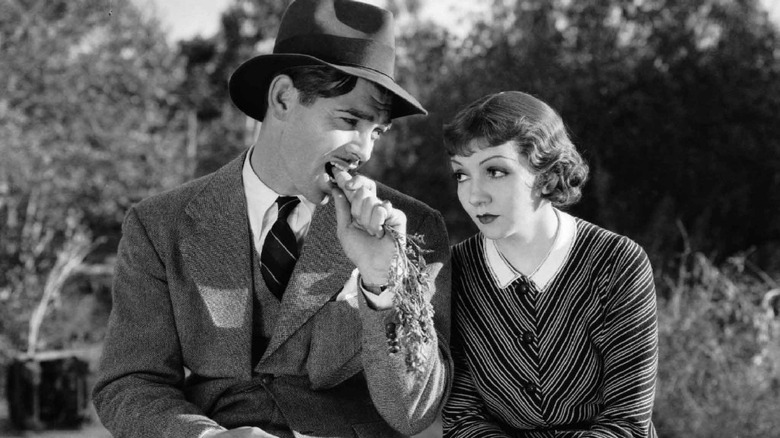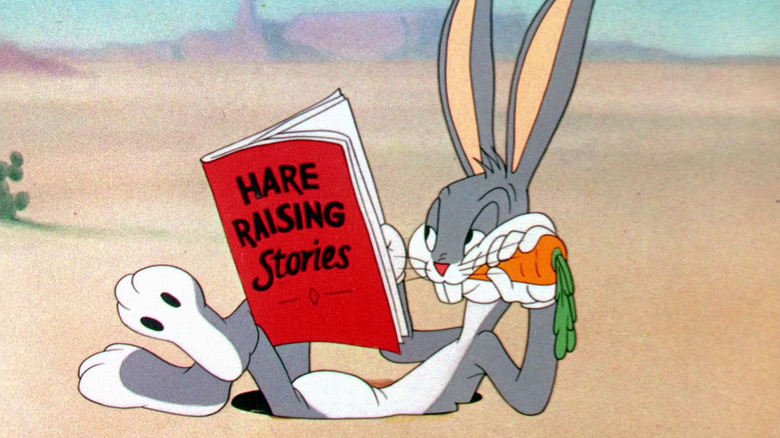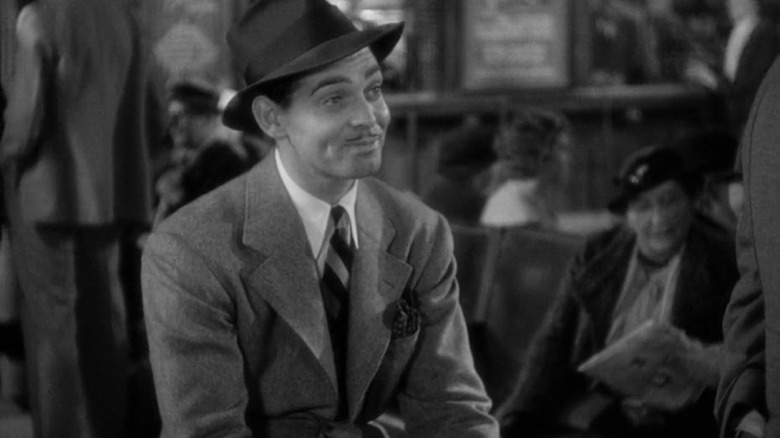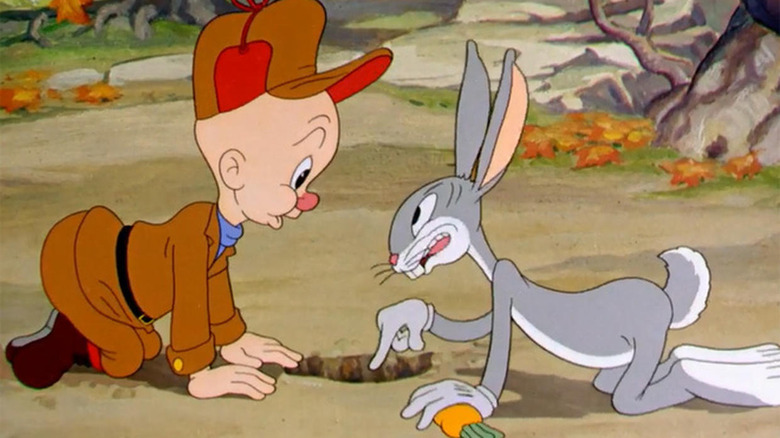The Surprising Way It Happened One Night Inspired Bugs Bunny

Even if you haven't seen Frank Capra's seminal 1934 romantic comedy "It Happened One Night," you've most certainly seen its progeny. "It Happened One Night" is one of those films around which much of popular culture pivots; a fulcrum for the way cinema was fundamentally altered. The genre of romantic comedy, of course, stretches back at least as far as the early days of ancient Greek theater, and was certainly codified in the 16th century with Commedia dell'arte (and updated for a modern English audience by Shakespeare). But it was Capra's film that solidified the genre in the new medium of cinema. It won the Big Five Academy Award categories (Screenplay, Actor, Actress, Director, and Picture) in 1934, and has gone on to inspire any romantic comedy wherein mismatched people fall in love on the road. Just as most modern sports movies are more or less renditions of "Rocky," many modern romantic comedies are constructed from the DNA of "It Happened One Night."
The film is about a rich heiress (Claudette Colbert) who eloped with a potentially gold-digging pilot against the wishes of her father. While being escorted back to her father, she gives her handler the slip and hops a bus to be reunited with her husband. On the way, she falls into the company of a roguish, handsome reporter (Clark Gable) who will aid her on her trip (as an heiress, she has little experience out in the real world) so long as he can write a story on her and get his career back on track. No points for guessing that they fall in love and in lust with each other - it's an unabashedly horny film. Gable's character is a fast-talking hustler-type, and his devil-may-care attitude is a character type we also still see to this day.
"It Happened One Night" also happened to be the favorite film of animator Friz Freleng, and was widely seen by other residents of Warner Bros. famous Termite Terrace, where some of the best short films of all time were produced and some of popular culture's most enduring characters were created. This was where Bugs Bunny was born, and his most famous traits come straight from "It Happened One Night."
What's Up, Doc?

The first "official" Bugs Bunny cartoon short was Tex Avery's 1940 film "A Wild Hare." Although there were proto versions of Bugs Bunny and Elmer Fudd in previous cartoons (purists will point you to the very Bugs Bunny-like rascally rabbit in Ben Hardaway's "Porky's Hare Hunt" from 1938; technically this was a character often dubbed "happy rabbit" who appeared in several shorts in '38 and '39), it was "A Wild Hare" that features the characters redesigned (by Bob Givens) into the versions that would eventually become their standard. It was also when Mel Blanc first used the enduring Bugs Bunny voice, and the first use of "What's up, doc?" It won the Academy Award for Best Animated Short.
Bugs Bunny would be passed around the Termite Terrace directors for the next decade. Chuck Jones made "Elmer's Pet Rabbit," Freleng made "Hiawatha's Rabbit Hunt," and Bob Clampett made "Wabbit Twouble," all in 1941. For the next few years, these three directors would take turns with Bugs. In '45 and '46, Frank Tashlin and Robert McKimson would also begin shepherding the character. Thanks to the Gods of Saturday Morning, these names are familiar to a generation of kids.
Bugs Bunny was a streetwise prankster who had no patience for humanity or authority, viewing us normies with a dismissive, winking bemusement. He was an agent of chaos, enacting slapstick vengeance against the hunters, the mean-spirited, and the bullies of the world. He was not so much a beacon of morality, as he was correcting injustice through sarcasm and sabotaged (I hope you pronounced that "sab-o-taa-gee'd") shotguns. If you became so impatient as to harm Bugs Bunny, the universe granted him license to abuse you for the rest of eternity, all while casually munching on a carrot, and that's where "It Happened One Night" comes into play.
The Unbearable Sensuality Of Clark Gable

"It Happened One Night" was no mere Oscar darling, nor was it simply the cornerstone of modern American romantic comedies, but it also an enormous worldwide hit. Adjusted for inflation, "It Happened One Night" made over $342 million, which would be quite the box office sensation today. But given the release pattern of movies in 1934 — films weren't released nationwide in every theater on the same day, but limited film prints of traveled around the country over the course of a few years — it's likely "It Happened One Night" was still playing somewhere as late as 1938. Films, as such, stayed in the popular consciousness for longer amounts of time, and the public continued to talk about them beyond their opening weekend. And, boy howdy, were people talking about Clark Gable.
In "It Happened One Night," Gable plays a character named Peter Warne, a man with has sparkle than a Stephenie Meyer vampire. He's tall, a bit rough-hewn, and unbearably handsome. He has a sloppy, roguish quality that appeals to just about everyone. It didn't hurt that Gable was aggressively sexy; there is a notorious scene in "It Happened One Night" wherein Peter and Ellie (the Claudette Colbert character) have to share a room for the night. When Ellie won't give Peter privacy to undress, he explains his undressing process to her ... as he undresses. Gable removed his shirt and was wearing no undershirt. That's a bare chest in 1934. It was more than most of us could take. This hasn't been substantiated, but a popular rumor about "It Happened One Night" was that sales of men's undershirts plummeted after Gable undressed for millions of people.
The qualities of Peter Warne bled out into the public's collective brainpan, and his qualities and tics began appearing in other media almost immediately. His charm was seen in romances. His roguishness appeared in pulp heroes (you best believe Han Solo owes him a debt). And his fast-talking appeared in Bugs Bunny. During a hitchhiking scene in "It Happened One Night," Peter talks fast, leans close, all while eating a carrot as a snack. Yeah, there's Bugs Bunny in a nutshell.
Ain't I A Stinker?

"It Happened One Night" also inspired the name of Bugs Bunny. "Bugs" was a slang term for crazy, as in, driven crazy by bugs, or perhaps the hallucinated bugs brought on by delirium tremens. One might say "bugnuts" today. It was a common nickname among gangsters and street toughs. There's no character named Bugs in "It Happened One Night," but Peter Warne, when talking to a character named Oscar Shapely (Roscoe Karns) makes up a threatening character named Bugs Dooley to frighten Oscar away. FilmSite.org says Friz Freleng's unpublished memoirs confirm this moment as the inspiration for Bugs Bunny. Oscar also called Peter "Doc" at one point, potentially inspiring Bugs Bunny's catchphrase. Although director Tex Avery maintains that "What's up, Doc?" was a common phrase in Texas where he grew up.
Of course Bugs Bunny is also inspired, in spirit, by vaudeville comedians, the Marx Bros., and the more rascally citizens of 1930s Brooklyn. Bugs was a magical amalgam of many things who has managed to persist for decades. But Clark Gable's spirit also lives on in the rascally rabbit. Maybe that's why we still like Bugs Bunny, even after two "Space Jam" movies.
Read this next: The 14 Best Animated Movies (That Aren't Made By Disney Or Pixar)
The post The Surprising Way It Happened One Night Inspired Bugs Bunny appeared first on /Film.
from /Film https://ift.tt/32DXxVS
No comments: